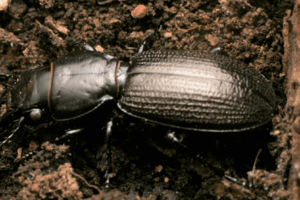Mecodema howitti facts for kids
Quick facts for kids Mecodema howitti |
|
|---|---|
 |
|
| Scientific classification | |
| Kingdom: | |
| Phylum: | |
| Class: | |
| Order: | |
| Family: | |
| Subfamily: |
Broscinae
|
| Tribe: |
Broscini
|
| Subtribe: |
Nothobroscina
|
| Genus: | |
| Species: |
M. howitti
|
| Binomial name | |
| Mecodema howitti |
|
The Mecodema howitti is a special type of ground beetle found only in New Zealand. It's also known as the Large Banks Peninsula ground beetle. This beetle is a carnivore, meaning it eats other smaller creatures. It lives in the forests of Banks Peninsula, which is in Canterbury, New Zealand. It's the biggest of the 16 types of ground beetles living in that area.
Scientists don't have much information about this beetle. It's considered a threatened species because it lives in a small area and isn't very common. More research is needed to help protect it.
Contents
What Does the Banks Peninsula Ground Beetle Look Like?
The Mecodema howitti is the largest ground beetle on Banks Peninsula. It can grow to be about 26 to 33 millimeters long (that's about 1 to 1.3 inches). These beetles cannot fly and are active mostly at night.
Their bodies are a dull black color. On their head, they have small hairs near their eyes. Their middle body part, called the thorax, is shaped like a heart. It often has sharp back corners. The wing covers, called elytra, are oval-shaped and sometimes look brownish-black.
Where Does This Beetle Live?
Mecodema howitti is one of about 430 ground beetle species found in New Zealand. It's also one of 63 Mecodema species that live only in New Zealand. This particular beetle lives in the central and eastern parts of Banks Peninsula, Canterbury. You can find them in both low-lying areas and higher up in the hills.
In the past, around the 1950s, they were also found in the western and northern parts of Banks Peninsula. However, they are no longer there. This is likely because their homes were destroyed and there are many predators in those areas. Their numbers have also dropped since the 1900s. This is probably due to forests being cut down for farms, forest fires, and more predators like hedgehogs and rats.
Scientists believe that the M. howitti might be in danger of disappearing in the next 50 years. They haven't been seen in the Port Hills since 1940 or in western Banks Peninsula since 1980.
What Kind of Home Does It Like?
Since Mecodema howitti cannot fly and is active at night, it prefers shady places with lots of plants. During the day, they hide under fallen logs or large branches. Like most other ground beetles, they like cool, damp spots.
They have been found hiding under rocks, but they are more common under woody debris. Logs are very important for their habitat. Logs help keep the ground moist and cool, and they can also attract more prey for the beetles to eat. Adult M. howitti can also burrow into the soil, so they don't rely only on wood for shelter.
How Does the Banks Peninsula Ground Beetle Live?
Daily and Seasonal Activities
The activities of M. howitti depend a lot on the temperature. They are most active during spring and summer. This is because their activity is linked to things like soil temperature, moisture, and rainfall. Even though they are usually nocturnal (active at night), they can be seen during the day if it's damp and not too bright. Daytime activity often happens during breeding times in spring and summer. They are mostly nocturnal because they are very easy targets for predators during the day. During winter, they are very inactive, so scientists think they might hibernate.
Not much is known about their eggs, young beetles (larvae), or how long they live. Scientists are still studying these things.
These beetles do not travel far, so different groups of them can become separated. Roads and farms have made these small groups even more isolated. This means that if there are big changes in their environment, these small groups could disappear.
What Do They Eat?
Mecodema howitti are carnivores that eat whatever smaller creatures they can find. They are not picky hunters. They are known to eat larvae (young insects), pupae (the stage before an adult insect), and adult invertebrates. Some examples include mealworm larvae, crane fly pupae, and adult Holcaspis suteri beetles. M. howitti often dig through the top layers of soil to find their food.
Who Are Their Predators?
Native animals that prey on M. howitti include the morepork (a type of owl) and the Buff weka (a flightless bird). However, Buff weka are no longer found on Banks Peninsula. Many introduced predators in the area also hunt insects at night. These include the possum, ferrets, weasels, rats, and hedgehogs.
Small mites from the Micromegistus group have been found living on M. howitti. Scientists think these mites only live on larger ground beetles. This might be because bigger beetles offer better places for the mites to live. The mites might also eat leftover food from the beetles.
Other Interesting Facts
Many native New Zealand species have cultural importance to Māori. However, it is not known if M. howitti is important to the local iwi (Māori tribes) in the Banks Peninsula area.
See also
In Spanish: Mecodema howitti para niños

